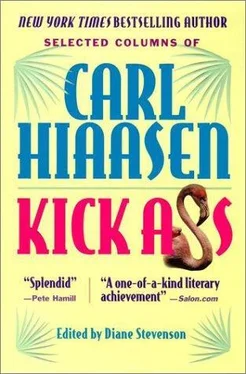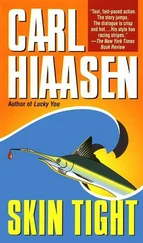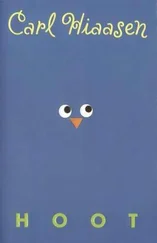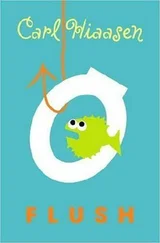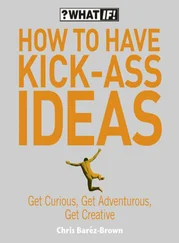And last year the former chairperson of the Greater Miami Chamber of Commerce, Dorothy Weaver, reported that an Uzi was stolen from her bedroom. I don't know if Uzis are now the standard-issue weapon for all Chamber of Commerce members, but it would be interesting to do a survey.
If South Florida is such a safe and desirable place to live, why are all these big shots packing heat?
A clue, in Mayor Daoud's case, is the special serial number engraved on his new Glock handgun: 007. The man thinks he's a secret agent!
Former Beach police chief Ken Glassman recounted how Daoud frequently asked to practice on the police firing range. When the chief balked, Daoud proudly produced a photograph of himself firing automatic rifles on a gun range in Israel.
The Israelis (at least those who had never visited Dade County) must have been quite amazed that the mayor of an American city would be so proficient in military skills. Watching Daoud in action, they could only conclude that Florida must be a much more exciting place than they had heard.
Let's assume that Daoud imagines himself to be a real secret agent. Why did he get four handguns? Even James Bond carried only one at a time. Maybe the mayor wanted a gun for both ankles and both hips, in case he's ambushed by enemy commandos at Penrod's.
The image of a heavily armed Alex Daoud cruising the streets is unsettling. Current gun laws can't even protect us from known felons and deranged maniacs, much less macho mayors.
Politicians shouldn't be trusted with anything more lethal than a gavel.The way things go, it won't be long before a burglar steals Daoud's heavy artillery, which will then be turned against the innocent citizenry of Miami Beach.
Let's just hope it doesn't happen during a travel agents' convention.
Live or rerun, murder is now mainstream TV
January 31, 1993
Not so long ago, parents were being warned that their kids could sneak out and buy black-market videotapes of people being murdered.
Today, snuff films have gone mainstream. You can watch them on the nightly news.
With a Miami TV crew looking on, Emilio Nunez Jr. emptied a semiautomatic handgun into his ex-wife. The tape of the killing was broadcast repeatedly by local stations, often accompanied by insightful freeze-frame analysis.
Like everyone else, I sat and watched. Pop, pop, pop. As domestic homicides go, it was noteworthy mainly for the ironic location (a cemetery), and for the forensic convenience of a camera capturing the crime.
Naturally, the Nunez tape became a hot property. TV stations all over the country picked it up. Some chose not to show the shooting, but many did. This was followed by the usual wrenching debate about violence on television—what's newsworthy, what's gratuitous gore.
Down here, there wasn't much discussion about whether to air the footage. It was a legitimate local story, extreme even by South Florida's diseased standards.
Now the crime is old news, but you can still catch the video almost any evening on local TV. Nunez's capture, his extradition hearing, his arraignment, an interview with his family—each new event is an excuse to cue the murder tape one more time.
Most stations considerately have cut the part when Nunez stands over his ex-wife and pumps slug after slug into her body. Yet some stations continue to show the jarring first shot to the head, punctuated by the cries of the interviewer.
More chilling than the murder itself is the fact that most viewers, myself included, are tired of seeing it. The Nunez tape has been broadcast so often that it no longer shocks. It should, but it doesn't.
Television has given America a unique intimacy with real-life violence. In 1963, Lee Harvey Oswald was shot on live TV It was the first murder my generation ever saw, and for a long time it was the only one. There was no such thing as Insta-cam.
The Zapruder film of John Kennedy's assassination now has been viewed by practically everybody, but for many years it was kept from the public because it was considered too horrible. These days nothing is too horrible.
Newscasters warned us that the Nunez video was graphic, but I don't know a soul who didn't watch it. Crime scenes always draw a crowd; hit-and-runs, holdups, lunatic sniper sprees. Video is the next best thing to being there.
Satellites feed the morbid craving. As if there's not enough carnage here in Florida, we now get nightly recaps of the bloodiest mayhem committed across the nation. Inundated visually, our shock threshold rises with each killing we see, whether live or on tape.
Gruesome at the time, the grainy black-and-white footage of Oswald's murder today seems prosaic. By contrast, Emilio Nunez's graveyard frenzy unfolds vividly, closeup and in living color. Even so, the impact wears off after the 13th or 14th viewing; probably sooner, for our kids.
We've seen so much that we've built up an unhealthy tolerance. Numbness sets in until there's a fresh fix. And we never need to wait too long.
On Thursday, police released the videotape of a Broward store clerk shooting a robber in the head. The incident occurred months ago, but who cares? They showed it on all the channels, again and again. As a bonus they played the 911 call, too.
Exciting stuff, this reality. They're doing it to death.
Great gift ideas for very young snipers-to-be
December 19, 1993
With all their caterwauling about juvenile violence, wimpy liberals in Washington have succeeded in intimidating toy dealers just in time for Christmas.
The country's largest retailer, Toys-R-Us, has decided to stop selling a Sega video game called "Night Trap."
I haven't played "NightTrap," but the plot seems fairly routine: Vampire home invaders drain the blood of nubile co-eds by drilling into the veins of their necks.
Fun for the whole family, right?
But after pantywaists in Congress complained about the "graphic" content, Toys-R-Us yanked the video off the shelves. In an atmosphere of such panic, what'll they ban next—toy guns?
I raced to the nearest Toys-R-Us outlet to find out. With great relief I can report that the store's arsenal remains fully stocked and ready for action.
For that future cocaine cowboy in your house, several toy Uzis are still available for about $3.99. My favorite is the Neon Uzi Squirter, a "clip loading" water gun that supposedly sounds like an authentic assault rifle.
If that's too much firepower for your trigger-happy tyke, start him out with something smaller—the .357 "Make My Day" Magnum, manufactured by Real Tech and sold for $7.99. The Clint Eastwood quip stolen for this toy's promotion actually referred to a .44, but that's quibbling. The "Make My Day" Magnum features "real firing sounds" and a rotating cylinder.
Kids growing up in big cities are much too streetwise to be amused by replicas of dinky Wild West six-shooters or clumsy muzzle-loaders. The shelves of Toys-R-Us amply reflect the precocious interests of today's urban youngster.
H. T. Toys sells an AK-47 water rifle that's unbeatable at $2.99, while Combat Force offers an adorable M-16 for $4.99.
A word of caution: According to the instructions, the M-16 is unsuitable for children under 3 years old—not because it's morally questionable to let toddlers play with toy weapons, but because they tend to disassemble them and swallow the plastic parts.
Not to worry.
The motto of the toy gun industry is: Safety, safety, safety! So many kids brandishing realistic-looking toy pistols have been shot by police and homeowners that many manufacturers have switched to neon colors, to avoid future confusion.
For example, the venerable Daisy Company offers a Buffalo Bill Rifle with an orange cap on the barrel to make it "easily identified as a toy." The gun promises a "loud bang," but the label warns: "Do not fire it closer to the ear than one foot."
Читать дальше
